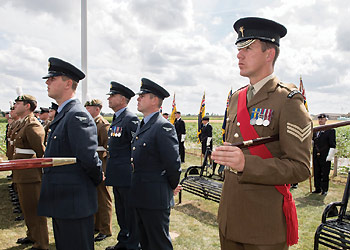|
Welsh National Ceremony of Remembrance - July 2017
|
100 years ago, on the first day of the 3rd Battle of Ypres (Passchendaele), 31st July 1917, the Welsh Guards crossed the line of departure at 04.24am. 138 Welsh Guardsman were killed or injured that day, while Sergeant Robert Bye, from Pontypridd, displayed conspicuous gallantry that led to him winning the Regiment’s first Victoria Cross. Passchendaele was one of the first battles where the creeping barrage was employed, as close as 50 yards ahead of the advancing troops. This was remarkably effective, but just as offensive tactics changed, so did the defensive measures used by the Germans. This was the first battle where the Germans used heavily reinforced concrete blockhouses, largely impervious to shelling.

The Welsh Memorial, Langemark
|

Gdsm Griffiths with his great-grandfather’s capbadge
|
Garrisoned by around 50 men operating 4 heavy machine guns and their own weapons, these blockhouses presented a formidable obstacle to the Welsh Guards. In Wood 15, one such blockhouse reaped carnage amongst the Welsh Guardsmen. Sergeant Bye crawled forward of his company, flanked the bunker, throwing in hand grenades to kill the defenders inside. He repeated this three times, and by the end of the day, Sergeant Bye had killed, captured or wounded over 70 Germans. He changed the course of the battle, inspiring other Welsh Guardsman to similar feats of bravery, proving that blockhouses were not impregnable. Lieutenant R R Jones crawled forward and succeeded in silencing one position by charging the bunker, pointing his rifle into the embrasure and killing the crew of a machine gun; he died later that day. Private Hughes 09 led the assault on Wood 16, killing or capturing the Germans entrenched there.
This was just the first day. Over the course of the subsequent months, the Welsh Guards were able to recuperate in camps to the rear, but this respite was brief. Battalions rotated in and out of the line, where patrols probed German defences and the threat of artillery was ever present. Ground so dearly won resembled a sea of mud, and the front-line was little more than a series of connected shell-holes. There were astonishing acts of bravery here. Private Lewis 59 refused to leave the front-line despite having been wounded in seven places. The French Army bestowed the Croix de Guerre on five members of the Battalion on 25th August. The remorseless fighting continued until November, when the front was stabilised and fighting seemed to be at an end. Throughout the battle, the Welsh Guards fought like lions, but suffered 451 casualties.
It was in that context of suffering and sacrifice, and of bravery and boldness, that in July 2017, eight members of the Battalion travelled to Ypres, to form part of the parading contingent for the Welsh National Service of Remembrance. Our Welsh comrades from both infantry and cavalry had also been part of the attack that day, with the 38th Welsh Division on the right of the Guards Division.

Sgt Cummins during the parade
|

The Regimental Lieutenant Colonel and the Colonel of the Regiment after the parade
|
We travelled by coach to Ypres, a city destroyed during the Great War, and now rebuilt. From the Cloth Hall to the Menin Gate, Ypres provided an appropriate setting for the many different services and ceremonies held over the last weekend of July. The threads of history woven into the fabric of Ypres were also continued by one of our own Guardsmen, Guardsman Adam Griffiths, who was wearing the same brass leek in his forage cap that his great-grandfather had worn 100 years ago whilst serving with the Battalion.
Our own part in the ceremonies was to take place at the Welsh National Memorial, at Langemark, close to the site where the Welsh poet, Hedd Wyn, was mortally wounded. Parading alongside contingents from the Queen’s Dragoon Guards, the Royal Welsh, as well as the Royal Navy and Royal Air Force, the Welsh Guards added more than a dash of Household Division panache. Sergeants Cummins and Thomas 90 came into their own, serving as ambassadors for the discipline, humour, and attention to detail required in ceremonial duties.
After two days of rehearsals, we paraded smartly, watched by The Prince of Wales and the Regimental Lieutenant Colonel, Major General Richard Stanford, as well as many guests from Wales, Flanders and Germany. A parade in blazing sunshine far removed from the torrential rain of 100 years ago went without a hitch, and later the streets of Ypres rang to the refrains of Calon Lan and Mae Hen Wllad as they must have done all those years ago.
We were all proud to have participated in the ceremony, proud of having heard the Last Post sounded at the Menin Gate, and fiercely proud of standing on the shoulders of the giants who wore the leek a century ago.
Paul Razzall
|
|




